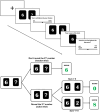The asymmetric impact of decision-making confidence on regret and relief
- PMID: 38650908
- PMCID: PMC11033447
- DOI: 10.3389/fpsyg.2024.1365743
The asymmetric impact of decision-making confidence on regret and relief
Abstract
When individuals make uncertain decisions, they often evaluate the correctness of their choices in what is referred to as decision-making confidence. The outcomes of such decision-making can lead to counterfactual thinking wherein alternative possible outcomes are contemplated. This, in turn, can elicit counterfactual emotions including upward and downward counterfactual thinking, which, respectively, refer to regret and relief. Decision-making confidence and counterfactual emotions have key effects on how individuals learn from the past and prepare for the future. However, there has been little understanding of how these experiences are related. For this study, 98 total adults were recruited with the goal of assessing the connections between decision-making confidence and sensations of regret and relief when completing a card-based gambling task. The results of this study suggest that decision-making confidence may reduce the intensity of relief while increasing the degree of regret experienced. These findings thus emphasize the important effect that decision confidence has on emotional processing.
Keywords: action effect; counterfactual thinking; decision-making confidence; regret; relief.
Copyright © 2024 Liu.
Conflict of interest statement
The author declares that the research was conducted in the absence of any commercial or financial relationships that could be construed as a potential conflict of interest.
Figures


Similar articles
-
"Should've known better": Counterfactual processing in disordered gambling.Addict Behav. 2021 Jan;112:106622. doi: 10.1016/j.addbeh.2020.106622. Epub 2020 Aug 26. Addict Behav. 2021. PMID: 32905866
-
Decision Reversibility and Satisfaction: The Mediating Role of Counterfactual Thinking and Anticipated Regret.Psychol Res Behav Manag. 2022 Aug 13;15:2193-2203. doi: 10.2147/PRBM.S364548. eCollection 2022. Psychol Res Behav Manag. 2022. PMID: 35990756 Free PMC article.
-
The development of regret and relief about the outcomes of risky decisions.J Exp Child Psychol. 2016 Aug;148:1-19. doi: 10.1016/j.jecp.2016.02.008. Epub 2016 Apr 17. J Exp Child Psychol. 2016. PMID: 27092742 Clinical Trial.
-
Counterfactual curiosity: motivated thinking about what might have been.Philos Trans R Soc Lond B Biol Sci. 2022 Dec 19;377(1866):20210340. doi: 10.1098/rstb.2021.0340. Epub 2022 Oct 31. Philos Trans R Soc Lond B Biol Sci. 2022. PMID: 36314158 Free PMC article. Review.
-
Counterfactual Thought.Annu Rev Psychol. 2016;67:135-57. doi: 10.1146/annurev-psych-122414-033249. Epub 2015 Sep 14. Annu Rev Psychol. 2016. PMID: 26393873 Review.
References
-
- Bell D. E. (1982). Regret in decision-making under uncertainty. Oper. Res. 30, 961–981. doi: 10.1287/opre.30.5.961 - DOI
LinkOut - more resources
Full Text Sources
Miscellaneous

